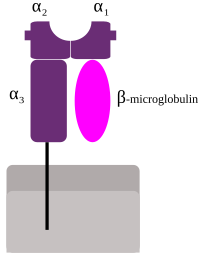
Photo from wikipedia
Background The recurrent oral ulcer frequently occur as a first clinical manifestation of Behcet’s disease (BD), but BD is characterised by considerable phenotypic variation, comprising a myriad of manifestations, e.g.… Click to show full abstract
Background The recurrent oral ulcer frequently occur as a first clinical manifestation of Behcet’s disease (BD), but BD is characterised by considerable phenotypic variation, comprising a myriad of manifestations, e.g. recurrent genital ulcers and skin, joint, eye, vascular and/or CNS involvement. BD is well known to be associated with HLA-B51 antigen. HLA B27 antigen is famous for association with spondyloarthropathy. But BD is also observed in HLA B27 positive patients. Objectives The aim of this study was to clarify the clinical features association with HLA-B antigens (B27, B51) in Korean patients of Behcet’s disease. Methods We genotyped HLA-B alleles in 433 patients who showed recurrent oral ulcer. The diagnosis of BD was determined according to revised international study group criteria. Among them, 126 patients of BD were included. The genotyping was performed using 66 sets of sequence specific DNA probe (PCR-SSP). The clinical feature was assessed according to HLA B allele in the patients diagnosed with BD. Results HLA-B51 allele frequency was more frequent in both 126 BD patients and 433 total patients and the frequency was 40 (31.7%) and 110 (25,4%) respectively. Among the HLA B51 +BD patients (n=40), similar gender ratio was observed (Male 52.5%, Female 47.5%) and clinical features of diagnostic criteria were dominant. Among the HLA B27 +BD patients (n=17), genital ulcer and skin lesions were dominant. HLA B27 +B51+BD patient was one and clinical features were genital ulcer, skin lesion and arthritis. Conclusions The specific clinical features of BD were observed in HLA-B51 +BD patients. In HLA B27 +BD patients, genital ulcer and skin lesions were more observed. The study about clinical features associated with HLA-B allele (B27, B51) in spondyloarthropathy patients is also needed. References [1] Hamzaoui A, Houman MH, Massouadia M, et al. Contribution of Hla-B51 in the susceptibility and specific clinical features of Behcet’s disease in Tunisian patients. Eur J Intern Med2012;23(4):347–9. [2] Sakly N, Boumiza R, Zrour-Hassen S, et al. HLA-B27 and HLA-B51 determination in Tunisian healthy subjects and patients with suspectedankylosing spondylitis and Behçet’s disease. Ann N Y Acad Sci2009;1173:564–9. [3] Montes-Cano MA, Conde-Jaldón M, García-Lozano JR, et al. HLA and non-HLA genes in Behçet’s disease: a multicentric study in the Spanish population. Arthritis Res Ther2013;15(5):R145. [4] Maldini C, Lavalley MP, Cheminant M, et al. Relationships of HLA-B51 or B5 genotype with Behcet’s disease clinical characteristics: systematic review and meta-analyses of observational studies. Rheumatology (Oxford)2012;51(5):887–900. Disclosure of Interest None declared
Journal Title: Annals of the Rheumatic Diseases
Year Published: 2018
Link to full text (if available)
Share on Social Media: Sign Up to like & get
recommendations!